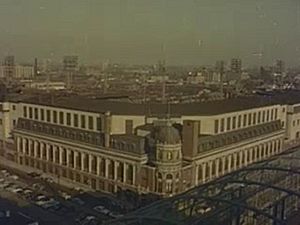Allegheny West, Philadelphia facts for kids
Quick facts for kids
Allegheny West
|
|
|---|---|

Shibe Park in Philadelphia's Swampoodle Neighborhood, is now a part of Allegheny West, circa 1955.
|
|
| Country | |
| State | Pennsylvania |
| County | Philadelphia |
| City | Philadelphia |
| Area codes | 215, 267, and 445 |
Allegheny West is a neighborhood located in the North Philadelphia part of Philadelphia, Pennsylvania, United States. It's named because it's near Allegheny Avenue, on the western side of Broad Street. It's a place with a lot of history and is always changing!
Contents
Discover Allegheny West
Like many areas in North Philadelphia, Allegheny West has seen many changes over the years. In the past, many factories and businesses closed down. This meant fewer jobs and people moving away.
However, the neighborhood is now seeing new life. Old industrial sites, like where Budd Steel used to build train parts, are being used for new things. Some have even become filming locations for movies!
A big food production building, the former Tasty Baking Co., is being updated. It's becoming a place with different kinds of businesses. The old headquarters building was taken down to make room for a new shopping center. This new center will have a large grocery store and other shops.
Homes in Allegheny West
Homes in Allegheny West are quite affordable. In 2005, the average price for a home in the 19132 zip code was $26,450. This was one of the lowest prices in Philadelphia at the time. Home values in the area grew by 9% between 2004 and 2005.
Some parts of Allegheny West also include areas of the 19129 zip code. This area is sometimes considered part of East Falls.
Who Lives in Allegheny West?
According to information from 2010, most people living in Allegheny West are African American.
- 97.5% of residents were African American.
- 0.8% were Hispanic.
- 0.7% were white.
- 0.2% were Asian.
- 0.8% were of mixed backgrounds.
What's a "Swampoodle"?
You might hear an old name for a part of Allegheny West called Swampoodle. This name isn't used much anymore. However, a train project in the 1980s, the SEPTA's proposed Swampoodle Connection, was named after it.
Historians describe Swampoodle as the area where three railroad lines met. This was near Lehigh Avenue and 22nd Streets. This railroad junction is now known as North Philadelphia station. It has been east of 22nd Street for a long time. It's possible that the name "Swampoodle" once covered the entire area between North Philadelphia station and 22nd Street.

